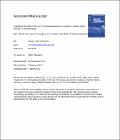| dc.contributor.author | GOODHUE, ROBBIE | en |
| dc.contributor.author | COXON, CATHERINE ELIZABETH | en |
| dc.date.accessioned | 2012-06-19T09:30:14Z | |
| dc.date.available | 2012-06-19T09:30:14Z | |
| dc.date.issued | 2012 | en |
| dc.date.submitted | 2012 | en |
| dc.identifier.citation | E. Minet, C.E. Coxon, R. Goodhue, K.G. Richards, R.M. Kalin, W. Meier-Augenstein, Evaluating the utility of 15N and 18O isotope abundance analyses to identify nitrate sources: A soil zone study, Water Research, 46, 2012, 3723 - 3736 | en |
| dc.identifier.other | Y | en |
| dc.identifier.uri | http://hdl.handle.net/2262/63813 | |
| dc.description | PUBLISHED | en |
| dc.description.abstract | 15N and 18O isotope abundance analyses in nitrate (NO3?) (expressed as ?15N-NO3? and ?18O-NO3? values respectively) have often been used in research to help identify NO3? sources in rural groundwater. However, questions have been raised over the limitations as overlaps in ? values may occur between N source types early in the leaching process. The aim of this study was to evaluate the utility of using stable isotopes for nitrate source tracking through the determination of ?15N-NO3? and ?18O-NO3? in the unsaturated zone from varying N source types (artificial fertiliser, dairy wastewater and cow slurry) and rates with contrasting isotopic compositions. Despite NO3? concentrations being often elevated, soil-water nitrate poorly mirrored the 15N content of applied N and therefore, ?15N-NO3? values were of limited assistance in clearly associating nitrate leaching with N inputs. Results suggest that the mineralisation and the nitrification of soil organic N, stimulated by previous and current intensive management, masked the cause of leaching from the isotopic prospective. ?18O-NO3? was of little use, as most values were close to or within the range expected for nitrification regardless of the treatment, which was attributed to the remineralisation of nitrate assimilated by bacteria (mineralisation-immobilisation turnover or MIT) or plants. Only in limited circumstances (low fertiliser application rate in tillage) could direct leaching of synthetic nitrate fertiliser be identified (?15N-NO3? < 0 ? and ?18O-NO3? > 15 ?). Nevertheless, some useful differences emerged between treatments. ?15N-NO3? values were lower where artificial fertiliser was applied compared with the unfertilised controls and organic waste treatments. Importantly, ?15N-NO3? and ?18O-NO3? variables were negatively correlated in the artificial fertiliser treatment (0.001 ? p ? 0.05, attributed to the varying proportion of fertiliser-derived and synthetic nitrate being leached) while positively correlated in the dairy wastewater plots (p ? 0.01, attributed to limited denitrification). These results suggest that it may be possible to distinguish some nitrate sources if analysing correlations between ? variables from the unsaturated zone. In grassland, the above correlations were related to N input rates, which partly controlled nitrate concentrations in the artificial fertiliser plots (high inputs translated into higher NO3? concentrations with an increasing proportion of fertiliser-derived and synthetic nitrate) and denitrification in the dairy wastewater plots (high inputs corresponded to more denitrification). As a consequence, nitrate source identification in grassland was more efficient at higher input rates due to differences in ? values widening between treatments. | en |
| dc.description.sponsorship | Enterprise Ireland | en |
| dc.format.extent | 3723 | en |
| dc.format.extent | 3736 | en |
| dc.language.iso | en | en |
| dc.relation.ispartofseries | Water Research | en |
| dc.relation.ispartofseries | 46 | en |
| dc.rights | Y | en |
| dc.subject | Geology | en |
| dc.subject | Nitrate | en |
| dc.subject | Soil-water | en |
| dc.subject | artificial fertiliser nitrogen | en |
| dc.title | Evaluating the utility of 15N and 18O isotope abundance analyses to identify nitrate sources: A soil zone study | en |
| dc.type | Journal Article | en |
| dc.type.supercollection | scholarly_publications | en |
| dc.type.supercollection | refereed_publications | en |
| dc.identifier.peoplefinderurl | http://people.tcd.ie/cecoxon | en |
| dc.identifier.peoplefinderurl | http://people.tcd.ie/goodhuer | en |
| dc.identifier.rssinternalid | 78763 | en |
| dc.identifier.rssuri | http://dx.doi.org/10.1016/j.watres.2012.03.004 | en |
| dc.contributor.sponsor | Teagasc | en |
| dc.contributor.sponsorGrantNumber | Walsh Fellowship 2005 | en |




